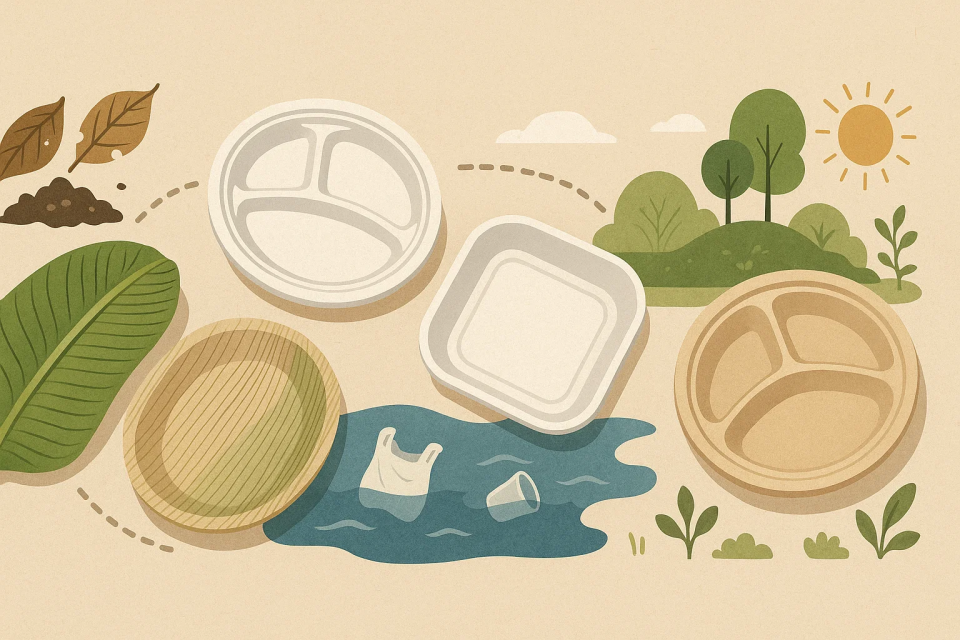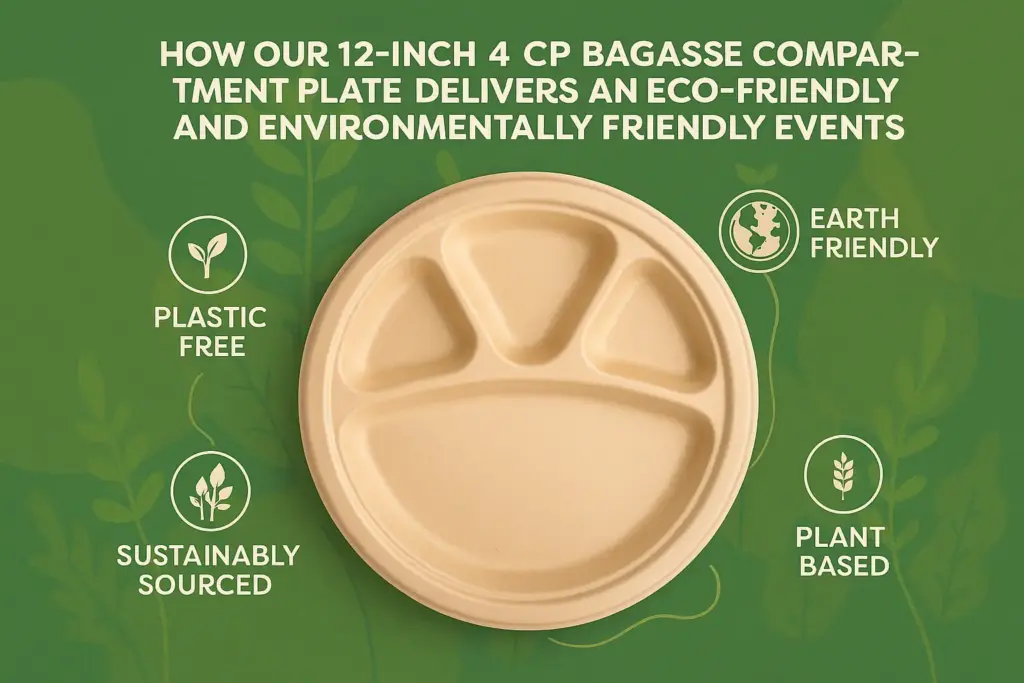As manufacturers of bagasse disposable tableware, we’re deeply committed to sustainability and helping our customers make environmentally conscious decisions every step of the way. While using sugarcane-based products is already a step in the right direction, composting them at home takes your green lifestyle to the next level.
Bagasse, the fibrous byproduct of sugarcane processing, is a fantastic alternative to plastic or foam disposables. It’s compostable, biodegradable, and renewable making it a top choice for eco-conscious households and businesses. But many people ask us, “Can I compost bagasse at home?” The answer is yes-with a little care and knowledge.
So, here’s our friendly, step-by-step guide to composting our plates, bowls, clamshell boxes, meal trays, and more, all made from 100% bagasse. Let’s dive in!
1. Break or Tear Products into Smaller Pieces
One of the simplest but most effective tricks in home composting is to shred, break, or tear your bagasse items into smaller bits before adding them to your compost pile. Why?
- Increased surface area: Smaller pieces give microbes more area to break down the material.
- Faster decomposition: You’ll see results more quickly, especially in smaller home composting setups.
If you’re composting larger items like meal trays or clamshell boxes, cut them into 2-3 inch pieces using scissors or break them by hand. Even tearing a plate in half makes a difference.
2. Keep Your Compost Pile Balanced
Healthy compost needs balance. Composting is essentially controlled decomposition, and for it to work efficiently, you need to maintain the right ratio of “green” and “brown” materials.
- Bagasse is a “brown” material, meaning it’s high in carbon.
- You’ll need to mix it with “green” materials that are nitrogen-rich, such as:
- Vegetable and fruit scraps
- Coffee grounds
- Grass clippings
- Fresh garden trimmings
A general rule of thumb is 2 parts brown to 1 part green. This ensures that your compost heats up properly, avoids unpleasant odors, and breaks down quickly.
3. Monitor Moisture Levels Closely
Moisture is one of the most overlooked aspects of home composting. Think of your compost pile like a sponge—it should be damp but not soaking wet.
Why moisture matters:
- Too dry? Decomposition slows dramatically.
- Too wet? The pile becomes anaerobic and may start to smell bad.
Check moisture weekly. If it feels dry, lightly sprinkle with water. If too wet, mix in dry brown materials like shredded newspaper or more bagasse pieces.
Pro tip: Covering your pile during rainy weather can help maintain the right moisture level.
4. Turn Your Compost Weekly for Better Airflow
Microbes responsible for breaking down your compost need oxygen to do their job. That’s where turning or aerating your pile comes in.
Turn your compost at least once a week using:
- A compost aerator
- A pitchfork or garden fork
- A compost tumbler (if you’re using one)
Regular turning:
- Speeds up the composting process
- Ensures even breakdown of materials
- Prevents unwanted smells
If you notice areas of your pile staying dry or undecomposed, turn more frequently or consider increasing your green material input.
5. Keep an Eye on the Temperature
Temperature is an excellent indicator of how well your compost is progressing. A healthy, active pile will warm up as microorganisms do their work. The ideal internal compost temperature ranges from 120°F to 160°F (49°C to 71°C).
While you don’t need a compost thermometer, it’s a useful tool—especially if you’re composting large amounts or want faster results.
Warm compost:
- Breaks down food and bagasse products quickly
- Kills off weed seeds and harmful pathogens
- Indicates an active, well-balanced pile
If your pile feels cool or cold, check your green/brown ratio and aerate thoroughly.
6. Use Compost Accelerators (Natural or Store-Bought)
Sometimes your compost needs a little boost. Enter compost accelerators—substances that help introduce active microbes and kick-start the decomposition process.
Some effective options include:
- A handful of finished compost from another pile
- Garden soil rich in microorganisms
- A scoop of cow or horse manure (if available)
- Store-bought compost activators (available at garden centers)
Adding these can help your bagasse products break down faster, especially if your pile has been stagnant or slow-moving.
7. Patience and Regular Observation are Key
Composting is part science, part art. Every pile is unique, depending on your materials, weather, pile size, and method. Bagasse products, when composted correctly, usually break down within 60 to 90 days, especially in warm weather.
What to look out for:
- Visible breakdown of bagasse pieces over time
- Earthy smell (not sour or rotten)
- Presence of worms, fungi, and insects (they’re good!)
- Heat in the center of the pile
Don’t be discouraged if it takes a little longer than expected. Composting is a process—and it’s worth the wait.
Quick Bagasse Composting Checklist
- Break products into smaller pieces
- Balance green and brown inputs
- Monitor and adjust moisture
- Turn pile weekly
- Keep it warm
- Add compost boosters
- Be patient and observant
A Final Friendly Note from the Team at PulpCraft
At PulpCraft, we’re not just manufacturers—we’re eco-advocates. We’re proud to offer 100% compostable bagasse tableware, free from plastic and chemicals, and perfect for eco-conscious homes, businesses, and events. Whether you’re using our 3-compartment plates, bowls, clamshells, or trays, know that you’re making a decision that’s better for the planet.
By composting our products at home, you’re closing the sustainability loop and helping create nutrient-rich compost that benefits your soil and reduces landfill waste. We hope these tips empower you to take the next step on your green journey.
Together, let’s nurture a cleaner, greener future—one plate at a time.
Explore our full range of compostable tableware at pulp-craft.com.
Frequently Asked Questions (FAQ)
1. Can bagasse plates be composted at home?
Yes, bagasse plates are 100% compostable and break down naturally in home compost systems.
2. What is bagasse made of?
Bagasse is the dry, fibrous pulp left after extracting juice from sugarcane—plant-based and chemical-free.
3. How long does it take to compost bagasse products?
Typically, 60–90 days in a balanced and well-aerated compost pile.
4. Should I cut bagasse items before composting?
Yes, tearing them into smaller pieces speeds up decomposition.


